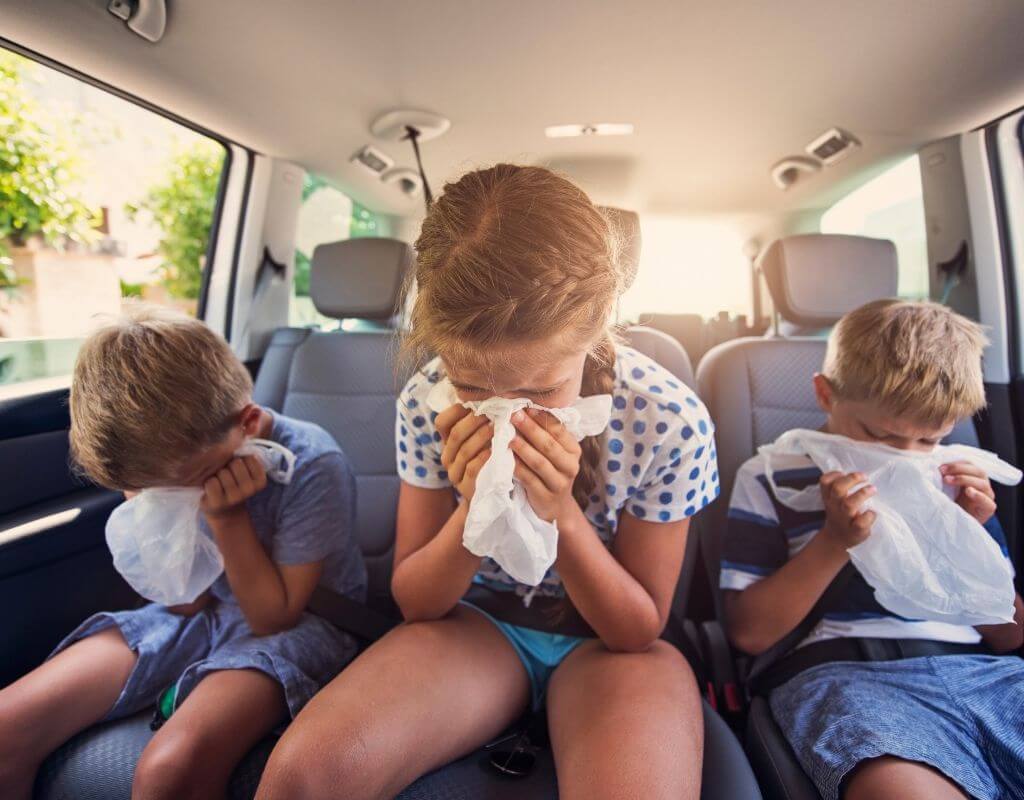There’s no faster way to take the shine off a family road trip than having a child in the back seat threatening to throw up – or worse still, bringing up their breakfast.
Motion sickness affects an estimated 30% of people, with children over the age of two years being particularly susceptible, so it makes sense to know what can trigger motion sickness and how to tackle symptoms quickly if they appear.
Symptoms of travel sickness
It is much more challenging to alleviate travel sickness once your child starts to show symptoms so the key to happy traveling is to avoid putting your child in situations that may encourage motion sickness, and then to act quickly if symptoms do start to appear.
Symptoms include:
- Dizziness
- Increased saliva
- Sweating
- Pale skin (some children can look quite green)
- Feeling of nausea
The best ways to avoid motion sickness altogether
Whether youre travelling by car, plane or boat, all motion sickness is caused by the brain receiving conflicting messages from our ears, eyes and sensors around our bodies about how our bodies are moving. For example, reading while travelling is a common cause of motion sickness because our inner ear reports motion to the brain while our eyes report that we are sitting still.
Children are more likely to suffer from travel sickness due to the fact that as they are smaller; they are able to see less out of the windows (which makes it harder to match the sensation of motion with what they are seeing) so their brains receive more conflicting motion messages.
If you are travelling with a known victim of motion sickness, the key to keeping them well is to take anti-motion sickness steps before you leave home. The following are known to have some success with keeping motion sickness away:
Ginger
Scientific studies have proven that ginger has strong anti-emetic (anti-vomiting) properties because it relaxes the stomach muscles. Ginger can be taken in tablets, as a tea, in crystallised form or in the raw before you travel and then taken at regular intervals during the trip. Some motion sickness sufferers have noticed that while ginger does reduce the chances of vomiting, it may not reduce the nausea.
Acupressure bands
Often used to keep sea sickness at bay, these work by applying continuous gentle pressure to an acupressure spot on the inside of your child’s wrist that relieves nausea. While you can apply the pressure yourself by pressing between the two tendons on the inside of your child’s wrist, the great charm of the acupressure bands is that kids can leave them on for as long as they are travelling and experience relief from symptoms. To get the desired results, make sure you get the acupressure bands before you leave home.
Medications
Motion sickness drugs are mostly the over-the-counter variety such as antihistamine. These drugs can both prevent and treat travel sickness and work by calming the stimulation of the inner ear. There are also drugs that can be prescribed for serious sufferers of travel sickness but generally the OTC drugs will do the trick. All drugs should be taken 30 minutes before travelling commences.
Eat light
While eating a big meal before leaving home isn’t recommended, if you know you or your child may fall victim to motion sickness, travelling on an empty stomach can have the same result. Instead eat a light meal of plain food at least 30 minutes before travelling.
Quick cures that work
Stop often
Once your child begins to feel motion sick, it can be hard for them to recover. The best and surest way to keep symptoms at bay (and alleviate symptoms your child may be experiencing) is to stop travelling regularly. Pulling over every 30 minutes for a five minute stretch of the legs can be the simplest and quickest way to resolve motion sickness. Obviously, this option is only available to you if your family is travelling by car!
Fresh air
Can’t stop the transport you’re on? Then the very next best thing to do is ensure that your child has plenty of fresh air. Whether that means positioning her near an open window or, on a plane, turning the over-head air vent on full blast, fresh air will definitely cool her down and prevents the overheating often associated with motion sickness.
Travel at night
By travelling at night our brain receives less conflicting signals – there’s not a lot to see out the window when it’s pitch black – and so is less likely to generate motion sickness symptoms.
Get a boost up
If you have young children who go green the very minute you pull out of the driveway, make sure that they are sitting in a seat that elevates them enough to comfortably look out the window. Being able to view the motion of the car works wonders when battling motion sickness.
Move to the front seat
Sitting up high in the backseat isn’t enough? Move the sufferer to the front seat if they are old enough. Being able to see the forward motion of the car usually significantly reduces symptoms of motion sickness. The bigger front passenger window also does a better job of delivering plenty of fresh air to the queasy sufferer
Nibble on a cracker
Very plain crackers eaten slowly will address the increased saliva problem that often comes with motion sickness. By reducing your child’s saliva, you will stop the nausea that is usually quick to follow. Other foods kids can eat that will have the same effect are olives and lemons but you might find a plain cracker is easier for them to swallow!
Look to the horizon
Tell your kids to look out to the horizon in the direction you are travelling when in the car. This will simplify the motion messages that their brain is receiving and help it to understand that your child’s body is in forward motion.
This article was written by Ella Walsh for Kidspot, New Zealand’s best family health resource.







When I was a child I suffered badly from car sickness, especially on the road between Napier and Wairoa travelling to see my grandparents. My grandmother found this tip that really worked. You put a piece of cottonwool in one ear only. It seems to rebalance the inner ear. I never got car sick again, using this tip every time we went somewhere.